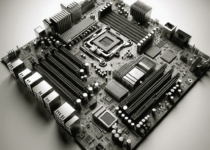Time to Clear the Air: Are Graphic Cards Universal?
As we delve into the captivating realm of computer graphics, a fundamental question often rears its head: Are graphic cards universal? This deceptively simple question opens up an intriguing discourse on the compatibility, functionality, and diversity of graphics cards in our technologically driven world. Understanding the universality–or lack thereof–of these quintessential components can transform your interaction with your personal computer or gaming console, taking it from mundane to magical.
This article aims to unravel this complex subject and offer you nuanced insights into the world of graphic cards. You may have heard contrasting views about their interchangeability and versatility. But don’t worry! By the end of this article, you will receive a brief answer to put all those doubts to rest. Buckle up for an enlightening journey that straddles both technical finesse and user-friendly explanations!
Compatibility: Are Graphic Cards Universal?
In the quest for an ultimate gaming or design experience, one frequently asked question among tech enthusiasts and professionals is: Are graphic cards universal? The answer, quite intriguingly, straddles between a ‘yes’ and a ‘no’. This might seem vague but allow me to illuminate you on this rather fascinating topic.
The universality of graphic cards is pegged more on their compatibility with motherboards than anything else. The majority of modern-day graphic cards adopt the PCIe (Peripheral Component Interconnect Express) interface, which is universally compatible with virtually all motherboards that possess a PCIe slot. Thus, from this standpoint, we can say they hold some level of universality. But here’s the catch: not every graphics card will work optimally with every motherboard or system due to varying factors such as power supply capacity or physical space within the computer case.
To spin things around, these constraints don’t undermine your ability to take your visual experience up a notch – whether in 3D rendering tasks or high-definition gaming escapades. Ultimately, what truly counts isn’t just about picking any universal graphics card; it’s about finding what fits – both literally and metaphorically – into your specific needs and system setup!
Factors determining GPU universality
The concept of “GPU universality” generally refers to the ability of a Graphics Processing Unit (GPU) to efficiently handle a wide range of computational tasks beyond traditional graphics rendering. Factors determining GPU universality include:
Architecture
GPUs with support for general-purpose programming frameworks like CUDA (Compute Unified Device Architecture) or OpenCL (Open Computing Language) are more adaptable. They can be used for a mixture of computational tasks beyond graphics.
Parallel Processing Power
Having more cores or stream processors enriches the GPU’s capability to execute parallel processing more efficiently, thereby making it applicable to a broader medley of parallel tasks.
Memory Bandwidth and Capacity
Faster and larger memory helps in handling large datasets and complex computations, making the GPU more universally applicable.
Precision and Accuracy
The ability to handle different levels of floating-point precision impacts the range of applications a GPU can efficiently support. Some tasks may require higher precision for accurate calculations.
Software Ecosystem
The availability of well-maintained and regularly updated drivers is crucial for ensuring compatibility with a wide range of software and applications.
Flexibility in Programming
The ability to write custom shaders and programs enables developers to leverage the GPU for specific tasks, enhancing its versatility.
Machine Learning and AI Acceleration
GPUs optimized for machine learning and artificial intelligence tasks often have specialized hardware features like tensor cores and support for lower precision (INT8 or INT4), expanding their range of applications.
APIs and Libraries Support
Support for popular libraries and APIs in the machine learning and scientific computing domains broadens the GPU’s usability for these specific applications.
Scalability
The ability to scale performance through multiple GPUs in a system enhances the overall computing power and makes the GPU suitable for more demanding tasks.
Notable Exceptions in Graphic Card Universality
While many modern graphics cards strive for universality by supporting a wide range of applications, there are certain exceptions and limitations based on specific design choices or target use cases. Here are some notable exceptions in graphic card universality:
Professional vs. Consumer Cards
Professional graphics cards (e.g., NVIDIA Quadro, AMD Radeon Pro) are designed for tasks like CAD, 3D rendering, and scientific simulations. While they offer features like ECC memory for enhanced accuracy, they might not perform as well in gaming or consumer-oriented applications compared to their gaming-focused counterparts.
Specialized AI Accelerators
Some GPUs are designed specifically for artificial intelligence workloads. While they can handle general-purpose computing, their architecture and features may be optimized for AI tasks, making them less suitable for certain traditional graphics applications.
Low-End Integrated GPUs
Integrated graphics found in entry-level CPUs may lack the power and features needed for demanding graphics tasks or parallel computing. These GPUs are typically designed for basic display purposes rather than high-performance computing.
Legacy GPUs
Older graphics cards may lack support for the latest APIs, lack modern features like ray tracing, or have limited memory bandwidth. While they can still handle certain tasks, they may not be as versatile as newer models.
Mobile GPUs
GPUs in mobile devices are often optimized for power efficiency and mobile applications. While they can handle graphics-intensive tasks on mobile platforms, their performance may not match that of dedicated desktop GPUs. Additionally, they might not support certain desktop-focused features or APIs.
Vendor-Specific Technologies
Graphics cards may be optimized for specific display technologies. For example, NVIDIA’s G-Sync and AMD’s FreeSync are technologies that synchronize the display’s refresh rate with the GPU’s rendering rate for smoother gaming. While they enhance the gaming experience, they are specific to their respective GPU brands.
Final Thoughts
In conclusion, graphic cards are not entirely universal due to various factors. The type of motherboard and its compatibility with the graphic card play an integral role in determining universality. In addition, different requirements based on user needs, such as gaming or professional designing, affect the specific type of graphic card required. Therefore, while there may be a common purpose for using a graphic card, its universality is limited by several variables. Consumers must evaluate these factors before deciding to ensure they choose a suitable graphics card that fits their specific needs and system configurations.
FAQs
Do all graphic cards fit into the same type of slot on a motherboard?
No, they do not. The most common types today are PCI Express (PCIe), but older motherboards might have AGP or PCI slots instead.
Can I install multiple graphic cards on my computer?
Yes, you can, but your motherboard must support SLI (for NVIDIA) or Crossfire (for AMD) technology.


